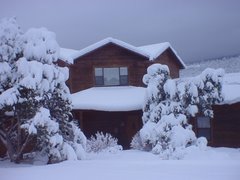We've been fascinated by the huge vegetable farms in the Salinas Valley so we took a guided Agriculture tour on Friday morning.
Our guide, Evan, has a graduate degree in agricultural, emphasis in grape-growing, and now runs a one-person tour business -- both agriculture tours and wine-tasting tours. He also does a little bit of ag-consulting one or two days a week.
He started out with some statistics, though, as so often is the case, made a tragic face and said it was a course in school that he hated when I told him what I was teaching. Anyhow, 2006 data showed 389,000 acres in Monterey County producing revenue of $3.5 billion. Lettuce and strawberries are the top two crops, revenue-wise, followed by nurseries producing all sorts of potted plants for nationwide sales. We hadn't seen the nurseries so we were surprised to learn about this. This is not a great picture, but maybe you get the idea. At one nursery there are 70 acres of greenhouses growing orchids.

We started off at a sewage treatment facility. All of the county's sewage is run through this facility, purified and constantly monitored, Evan assured us, and used for irrigation and to recharge the aquifer. As fresh water is removed from the aquifer, sea water intrudes and this is a danger that the agriculture industry wants very much to avoid. Now, apparently, there are some regions that won't buy food produced that has been irrigated by purified waste water, so there is a continued effort to convince the populace that it's not dangerous.
Next, we drove by the Dole veggie cooler and shipping dock. Everything is bar-coded and handled robotically. Some 400 trucks load and go here daily. The key to vegetable production is to get it out of the field and into refrigerated storage as quickly as possible. (We had seen a good video on this in the Ag Museum in Salinas that shares space with the Steinbeck Museum.) The high cost of diesel fuel is making it very expensive to ship lettuce to the east coast,so there is some effort being launched to encourage vegetable growing in the SE US. The trouble is that it's either too hot or too cold at different times of the year in that area.
The Salinas valley is ideal for growing vegetables -- long growing season (two or three crops per year in most cases), cool year-round climate, fog for moisture and sun-protection, very fertile soil. But, you've got to get it to market.
The northernmost few miles of the valley, where they get the most fog (the Salinas R flows S to N where it empties into the ocean), is where artichokes are grown: 95% of the country's fresh artichokes come from here. Marinated artichokes come from Spain and Italy. We stopped at an artichoke stand and packaging plant to watch the operation and get Evan's advice on how to cook an artichoke. Some of the other five passengers on our tour were from the area and had their own advice.

Lettuce-picking and packing is semi-mechanized. Tractors with big wing extensions drive down the rows. 10-15 pickers follow, cutting the lettuce heads and placing them on a conveyer that deposits them where other crew members, riding or walking, I'm not sure, box them immediately. The boxes are soon off-loaded and trucked to the Dole cooler. Being a member of a lettuce crew is considered the top job in the fields.
We got to stop at a strawberry field and pick and eat samples. Outstanding! Strawberries are grown in raised beds of two rows of strawberries. The beds are raised to facilitate strawberry-picking. Here Susie is auditioning for the job of strawberry picker -- NOT!

These strawberries are ever-bearing varieties and are harvested every three days throughout the season. Drip tubes provide irrigation. The ground is covered with plastic tarp to protect the growing strawberries. They drive tractors through these rows and vacuum out insects.

Evan's data show $440,000,000 dollars worth of strawberries from almost 10,000 acres in 2006, so that's $44,000 per acre, which is pretty good return. Evan told us that farmland sells for $60,000 to $70,000 per acre, the most expensive anywhere.
Susie asked him about the case of a few years ago, 2005, I think, when a spinach field was contaminated by e coli. That led to quite a story. Apparently e coli was somehow transmitted from a horse pasture to a nearby spinach field. E coli requires water to survive and there doesn't seem to be any water- borne way to get it from one site to the other. Many investigations were done trying to reproduce the transmittal, but no cause was ever found. Nevertheless, all sorts of regulations have been instituted: You can't have livestock within a mile of a field. If a large bird, such as a Canadian goose, or a dog is seen in a field, you have to stake out an area around the site and can't pick from there. Now, I think this applies to all crops, not just spinach, but if so, there are many violations in terms of stock proximity to foodstuffs. It's immediately devastating to be seen as a threat to consumer health. Spinach production dropped 40% from 2005 to 2006 and is about down to nothing now.
Well, in our van tour of the area there hadn't been too many opportunities for picture-taking, so Susie and I went out in the afternoon to enjoy the scenery and get a few pictures, including a couple of barns.





Cheers,
Rob and Susie







No comments:
Post a Comment